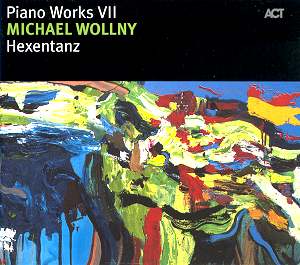Initiation (Wollny) [4:27]
Schubertiade: Der Doppelgänger (Wollny)
[2:37]
Schubertiade: Das Irricht (Wollny) [2:39]
Schubertiade: Der Schatten (Wollny) [2:00]
Schubertiade: Der Wanderer (Wollny) [2:28]
Anchor Song (Wollny, based on a composition
by Björk) [2:30]
Hexentanz: Teil 1 (Wollny) [2:56]
Hexentanz: Teil 2 (Wollny) [3:40]
Hexentanz: Teil 3 (Wollny) [2:12]
Hexentanz: Teil 4 (Wollny) [2:01]
Hexentanz: Teil 5 (Wollny) [3:01]
Spell / Enchantment (Wollny) [4:47]
Augmented Time (Wollny) [4:13]
Where is the Line (Wollny, based on a composition
by Björk) [3:23]
Spuk (Wollny) [2:38]
Die lebenden Puppen (Wollny) [3:08]
Joga (Wollny, based on a composition by Björk)
[3:37]
rec. Studio Zerkall, Germany, August &
November, 2006
It isn’t often that one finds
Schubert and Björk on the same album,
but Michael Wollny is nothing if not eclectic
and omnivorous in his music. Still under 30,
Wollney is a gifted pianist who has worked
with many of the leading German jazz musicians,
including both Emil and Albert Mangelsdorff
and has made two outstanding duo records with
the veteran tenor player Heinz Sauer – Certain
Beauty (ACT 9444-2) and Melancholia
(ACT 9433-2). He is also a member of the much-praised
trio [em] along with Eva Kruse (bass) and
Eric Schaefer (drums).
On this album – his first
solo CD, I think – he has chosen to devise
a themed collection, almost a huge suite.
All the pieces here are linked
by the theme of the Gothic. Planning for the
project, Roland Spiegel’s booklet notes tell
us that "Wollney retreated for a month
to the island of Gotland. He listened to Schubert,
Steve Reich, Björk and music by Joachim
Kuhn (much revered by Wollny), read Edgar
Allan Poe and studied films by Werner Herzog,
David Lynch and not least Ken Russell’s 1986
work ‘Gothic’: a film that fascinated Wollny
as a ‘grotesque brainstorm on the subject’".
The resulting music is intriguing
– there are no ‘Hammer Horror’ clichés
here. The pieces which have Schubertian titles
don’t seem to use themes from Schubert, but
rather to evoke, or gesture towards, the dark
romanticism of some of Schubert’s subjects.
Here, and elsewhere, there are some sparse,
brooding passages in which silence is as important
as sound; there are Keith Jarrett like clusters
and emphasised chords, mixed with yearningly
lyrical runs; there are rumbling low chords
and rapid figurations high in the right hand;
there is some reaching inside the piano to
dampen the strings; there are sudden skittering
runs which seem to be driven by some unnamed
compulsion. But predominantly the music is
slow, often broken and fragmentary, its ‘gothic’
disturbance more of mind than event.
One might, finally, wish
for a bit more variety of mood if listening
to the CD straight through. But there’s no
doubting either Wollny’s musical imagination
or his very assured technique at the keyboard.
This is a young musician we shall be listening
to for many years.
Glyn Pursglove
